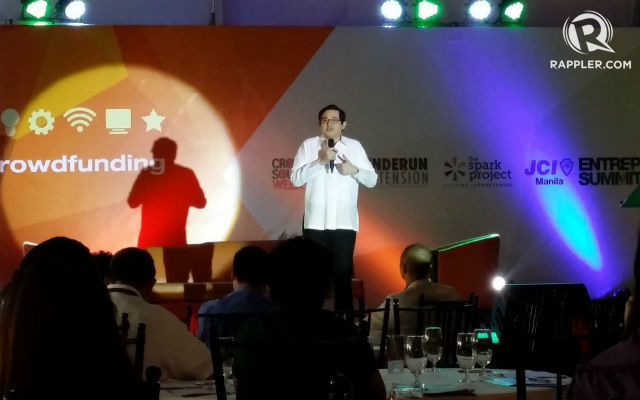Is crowdfunding the future of businesses in PH?
MANILA, Philippines – How does crowdfunding work? What solutions can it offer business startups and social enterprises in the Philippines?
According to Senator Bam Aquino, the current banking system makes it very difficult for small and medium enterprises (SMEs) and business startups to get the financing they need. But for large corporations, it is very easy to get loans – in fact, banks knock at their doors with offers.
“If you’re a micro to pre-medium business and you need around P500,000 to P5 million but you don’t have collateral – even if you have a contract, idea or a business model – you still won’t get the financing you need,” the senator added.
This is why Filipinos need to look for alternative finance sources like crowdfunding, Aquino noted.
During the 1st Philippine Crowdfunding Conference in Manila on Wednesday, March 18, business experts and successful entrepreneurs discussed crowdfunding and crowdsourcing and how these concepts can be applied in Philippine businesses.
Crowdfunding for small businesses
Crowdfunding is the thriving practice of funding a venture through raising monetary contributions from a group of people. The advancement of social media has particularly made this practice successful for business startups in other countries.
Aquino believes it can work for the Philippine economy.
“As we go around different areas, we find that putting up a small enterprise is becoming the best solution for Filipinos. But they need the right support to be able to turn their ideas into fruition. Crowdfunding might be the best way to move this sector forward,” Aquino said.
The senator, who authored the Go Negosyo Act of 2014, emphasized the importance of empowering social enterprises and SMEs in promoting inclusive growth in the country.
“If we will support our SMEs, who’s to say that we can’t enter the next phase of where the Philippines should be – a middle income economy where opportunities are (available) for more Filipinos?” Aquino said.
He added: “Each part of the chain of our countrymen should be able to get that opportunity to put up their business and turn their ideas into fruition. This is the best place for crowdfunding to come in.”
Crowdfunding and social media
Crowdsourcing Week Founder Epi Nekaj says crowdsourcing and crowd funding are causing disruptions in the world’s finance systems.
Epi Ludvik Nekaj, founder of Crowdsourcing Week, said crowdfunding started because of two major factors – social media and the world financial crisis in 2008, which gave birth to crowd companies.
“Millions of people right now are becoming bankers. That’s why banks right now are trying to figure out if their business model is broken or outdated,” he said.
The Internet continues to contribute to the growth of crowdsourcing and crowdfunding. According to experts, everyone will be connected to the Internet by 2035.
“This means the future of content is human-powered content. Who runs the Internet? There’s no single entity that runs it. You are the Internet. We are the Internet,” Nekaj said.
He added: “Crowdsourcing is about passion. It’s about talents, skills, and resources. When we talk about crowdsourcing and crowdfunding, we need to make sure that we’re really tapping the resources that the crowds have.
Crowdsourcing spawns innovation and social media spawns connection.”
Nekaj said that there are 4 types of crowdfunding platforms. These are:
- Donation – the crowd gives money or other resources to support the cause.
- Reward-based – the crowd gives money in exchange for a reward (a product or service) that the company will provide or produce
- Equity-based – the members of the crowd become part-owners of the company raising funds
- Lending – the company merely borrows the money from the crowd with a legally binding contract that the loan will be repaid
In Asia, Nekaj noted that crowdfunding is more inclined toward equity and lending. This is because these systems challenge founders to finish the project – since 70% of crowdfunding programs do not deliver on time.
“There is so much potential in Asia. By 2025, the volume of investment crowdfunding will be $92 billion, according to experts,” he added.
Harnessing the power of the crowds
Crowdsourcing efforts have actually been used in past projects in the Philippines. Rappler’s investigative desk editor Chay Hofilena discussed how the news website has utilized crowdsourcing in its past efforts.
In Football for Peace, Rappler and the Philippine marines were able to raise 2,400 indestructible balls for kids in conflict areas through donations.
Meanwhile, Project Agos constantly calls out for volunteers who help scan social media for calls of help during disasters.
All these campaigns were amplified by social media.
“We’ve seen that social media has the potential for social change. It’s a mobilization tool we can use to harness the good in people,” Hofilena said.
Crowdsourcing has also democratized the way media organizations cover news.
“It’s no longer a top-down editorial approach. Now, the public can set the news agenda by stating the issues that concern them and issues that matter to them. It has allowed the media to become real agents of change,” she added.
The way of the future
Nekaj believes crowdfunding will continue to change the world’s finance systems in the future.
“A bank is a place that will lend you money if you can prove that you don’t need it. Alternative financing is developing because of this. We don’t need more banks. We need more banking,” he added.
While social media has become a powerful tool in crowdsourcing and crowdfunding, people still need to wield it carefully he said.
“There’s nothing wrong with social media, but we have to be socially productive. You should be that entity that thinks forward. We need to be part of a socially productive ecosystem in crowdsourcing,” Nekaj stressed.
Source: Rappler

Recent Comments